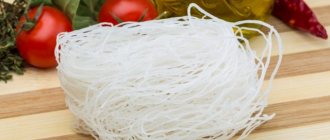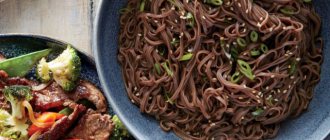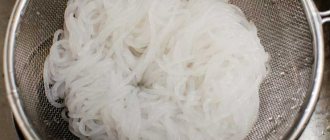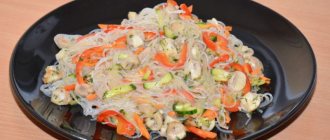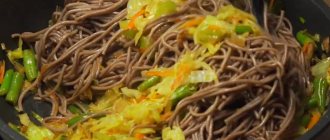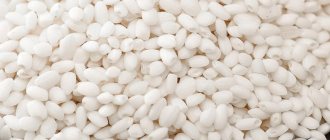Chemical composition of rice noodles
Rice noodles are pasta products made from rice flour. Due to its transparent structure, it is also called glass. In appearance, it is often confused with funchose. The difference is that the latter consists of bean starch.
This healthy product does not require boiling. Before eating, simply add hot water and leave for a few minutes. The main advantage of the product is its composition. It is gluten-free, fiber-free and salt-free. Due to this, the noodles are easily digestible and do not provoke an allergic reaction. The chemical composition of the product is represented by the following components:
We recommend reading: Gluten: what it is and why it is harmful, where it is found, symptoms of intolerance
- vitamins of groups E, PP and B;
- iron;
- copper;
- calcium;
- alimentary fiber;
- selenium;
- sodium;
- phosphorus;
- potassium;
- saturated fatty acids.
Rice noodles contain 7% protein
The mineral content ensures the strengthening of the musculoskeletal system. Vitamin B present in the composition has a positive effect on the condition of the skin. Iron helps prevent anemia. Saturated fatty acids provide the body with energy and promote the absorption of other components.
Attention! Rice noodles are white in color due to their starch content.
Composition and nutritional value of pasta
The exact composition of pasta depends on several factors. Different producers use different varieties of wheat. The most useful are those created from durum varieties. They contain more gluten, but less starch compared to products created on the basis of soft varieties. Therefore, the first type of product can practically not harm the figure.
What else is the benefit of such food? Pasta contains B vitamins, which improves the quality of skin, nails and hair. This food also makes the brain and heart work better. It also contains fiber, which normalizes the functioning of the gastrointestinal tract. But all this is true only in relation to high-quality pasta.
Photo source: shutterstock.com
As for the nutritional value of the product, BZHU in this case is an unstable indicator, since it varies depending on the type of product. But the glycemic index is a completely stable category. This is 40 GI, but not for 1 piece, but for the standard 100 grams.
What are the benefits of rice noodles?
Rice noodles are considered a rich source of many substances needed by the body. It contains 8 amino acids that take part in the most important life processes. It perfectly satisfies hunger, combining well with many foods.
Its beneficial properties include:
- fast saturation;
- normalization of nutrient balance;
- regulation of the gastrointestinal tract;
- replenishment of energy reserves;
- prevention of anemia;
- easy digestibility.
Experts recommend including rice noodles in the diet of people suffering from diseases of the cardiovascular system. It is especially useful for children and the elderly. Since the product does not contain fiber, it does not cause flatulence or stomach pain. After using it, there is no heaviness.
Due to the sodium and potassium content, rice flour vermicelli normalizes the water-salt balance, which helps get rid of edema. Due to the presence of magnesium in the composition, the product has a positive effect on the functioning of the cardiovascular system. The rich content of vitamin B ensures stabilization of the emotional state. Since noodles are complex carbohydrates, consuming them reduces the need for fats and glucose. This has a positive effect on your figure.
Benefits of instant noodles
Doshirak products are an indispensable product on the road, on hikes, at work. In almost all cases when you need a quick and satisfying snack. The food takes up little space, weighs little and is quickly prepared.
In addition to household amenities, the benefits of noodles for humans are expressed by the following factors:
- provides the body with fiber;
- saturates with protein, carbohydrates and fat;
- restores the balance of sodium and iron;
You can combine Doshirak with other foods. Pure products without impurities, do not contain harmful substances that can harm health.
Harm of rice noodles
The benefits and harms of rice noodles are especially important to know when dieting. The product has many more positive properties. But there is an opinion that if consumed in excess, rice noodles can provoke the development of kidney and bladder cancer. This is due to the content of toxic substances in the product. The disadvantages include the bland taste of Asian vermicelli. To enrich it, fatty sauces and various flavor enhancers are often used in seasonings. They increase the calorie content of the dish and have a negative impact on health. To minimize the harm from a dish, it is enough to choose a safe dressing.
Useful properties of the product
The main value of wheat noodles lies in fiber. This is the solid part of plants that is not digestible by the human body. Fiber is a vital plant element, without which we are unable to fully function. Wheat contains soluble fiber. As soon as it penetrates inside, it turns into a liquid gel that gently envelops the organs, further protecting them.
It is fiber that regulates the concentration of sugar and cholesterol in the blood, is responsible for the quality of intestinal function, ensures long-term satiety and makes our skin healthier. The substance harmonizes the internal microflora, and this is reflected both in the overall performance and appearance of a person. Increasing fiber in your diet will make waking up in the morning less painful, increase your energy, and make you glow from the inside out. The plant component also protects us from breast and colon cancer.
Important: A standard bowl of whole grain wheat noodles contains up to 7 grams of fiber. The daily intake for an adult varies from 30 to 50 grams.
In addition to fiber, the product contains vitamins and beneficial nutrients, but heat treatment minimizes their concentration. You can increase the benefits of the finished dish by adding additional ingredients:
- healthy fats – vegetable oils, nuts, avocados;
- protein – lean meats and fish, legumes;
- easily digestible carbohydrates - vegetables, fruits.
The product also has a beneficial effect on the functioning of the nervous system. B vitamins, which are contained in grain, act as a natural antidepressant - they harmonize the psycho-emotional state and reduce anxiety. Eating a balanced portion of food can really help you relax and take a breather after a hard day.
Interesting: George Ozawa, the creator of Zen Macrobiotics, divides all foods into Yin and Yang. All products correspond to the basics of polarity and, in the right combination, make a person healthy, and in the wrong combination lead to serious disorders and diseases. The author categorizes wheat noodles as Yang. It is considered to be the most beneficial and can minimize harm from Yin food.
How many calories are in rice noodles
The calorie content of rice noodles in finished form is 108 kcal per 100 g of product. A serving of a finished dish averages 200-250 g. Its calorie content does not exceed 300 kcal, which is considered below average for a side dish. The contents of the BZHU are as follows:
- proteins – 1.8 g;
- fats – 0.2 g;
- carbohydrates – 24 g.
Rice vermicelli dishes are recommended to be eaten with chopsticks
Calorie content of egg noodles and its properties
Egg noodles can be thick and short, long and thin. Most often on sale you can find flat products of medium length yellow. Regardless of the shape and size, the calorie content of egg noodles and its nutritional properties are always the same. Some varieties of this product are made without eggs or with only egg whites, despite the name. This versatile product is a delicious variation on traditional Italian pasta, and the enriched egg noodles are a good source of nutrition, containing many important vitamins and minerals.
Contraindications for rice noodles
Asian noodles made from rice flour are an easily digestible and nutritious product. But in some cases, its use should be abandoned. One of the main reasons is an allergic reaction. It occurs very rarely because the noodles do not contain gluten. Patients with diabetes need to be careful when introducing the product into their diet. Its glycemic index is 61, which is average.
It is equally important to pay attention to the quality of the product. When making counterfeits, bleaches containing lead and aluminum salts are used. They are necessary to give the product a suitable shade. These substances have a devastating effect on health. Therefore, rice noodles should only be purchased from trusted places.
Use of the ingredient in cooking
Glass noodles are produced in several variations - length and thickness vary. The food tastes identical, the only difference is the size. The formed dough is rolled out, then passed through a molding hole or cut with huge knives into strips of the required width. Noodles are made from both fresh dough and dried dough - the taste and structure of the finished dish depends on this.
The peculiarity of the product is its bland, neutral taste. Noodles perfectly absorb other tastes/aromas, are filled with them and become the center of a gastronomic composition. There are several ways to prepare glass noodles. The most common of them is boiling; frying, baking, deep-frying and steaming/soaking are also acceptable (typical for the thinnest noodles). Cooking time depends on the thickness and length of the dough - the longer, the longer it will take to cook.
The ingredient can be combined with:
- meat;
- bird;
- seafood/fish;
- fruits;
- vegetables;
- cheese;
- mushrooms;
- cottage cheese;
- dried fruits/nuts;
- various sauces.
Noodles are perfect for making soups, appetizers, warm or cold salads, and side dishes. The only limitation is your culinary imagination. Don't be afraid to experiment! Combine noodles not only with traditional Asian ingredients, but also with any product you find in the refrigerator.
Rules for preparing the product
Properly prepared funchose is the key to a successful dish. If the diameter of the product does not exceed 0.5 millimeters, then simply pour boiling water over it and leave for 5-7 minutes. The noodles will swell slightly, become soft, pliable and change color. After 5 minutes, drain the water, rinse the noodles and serve or combine with other ingredients.
If the diameter of the product exceeds 0.5 millimeters, then cook the noodles like regular pasta from refined grains. Place the component in boiling water and remove from heat after 3-5 minutes.
Determining the readiness of funchose is very simple: undercooked one will stick to the tooth enamel, and overcooked one will fall apart right in the pan. Properly prepared glass funchose is soft, slightly crunchy and neutral in taste.
To prevent the funchose from sticking together during boiling, add a drop of vegetable oil to the water. The ideal ratio is 1 tablespoon of vegetable oil per 1 liter of liquid.
Funchoza in the form of twisted skeins requires special attention and care in preparation. Tie a skein of noodles with thread, fill a deep pan with liquid at the rate of 1 liter of water per 100 grams of product, pour in 1 tablespoon of oil and 1 teaspoon of salt (per 100 grams). Bring the mixture to a boil, then drop the noodle skein into the boiling liquid. Boil the noodles for 3-4 minutes, drain in a colander, and rinse with cold water. Take the thread that you tied onto the skein earlier and shake the funchose thoroughly to remove excess water. Then place the skein on a cutting board, cut the thread, and chop the funchose into strips of the desired size.
Recipe for funchose with chicken and vegetables
Nutritional value of the dish
| Calorie content | Squirrels | Fats | Carbohydrates |
| 383 kcal | 34.3 g | 2 g | 58.8 g |
We will need:
- chicken fillet – 500 g;
- glass noodles – 200 g;
- green beans – 400 g;
- soy sauce – 50 ml;
- rice vinegar – 50 ml;
- sweet bell pepper – 1 piece;
- carrots – 1 piece;
- onion – 2 pcs;
- garlic – 3 cloves;
- salt/pepper to taste.
Preparation
Remove skin and lumps of fat from the chicken fillet, rinse, then cut into long slices. Roll the prepared meat in your favorite spices, add chopped onion, fry in a pan or, if desired, bake in the oven.
Prepare glass noodles according to package instructions. When ready, drain the noodles in a colander and rinse under cold water.
Such manipulations will help achieve a delicate structure and a richer taste.
Cut the sweet bell pepper into thin strips and grate the carrots on a coarse grater. Boil the green beans until tender. Combine all prepared ingredients in a frying pan, add 2-3 cloves of garlic and fry until soft. You can use your favorite spices during the frying process.
In a deep container, mix prepared glass noodles, fried vegetables and chicken, season with rice vinegar and soy sauce. Mix the contents of the container thoroughly and leave for 3-5 minutes so that each ingredient is saturated with a wealth of flavors and aromas. Serve immediately after cooking.
Rules for eating rice noodles
Before preparing noodles, you need to study the recommendations indicated on the package. The product must be filled with hot water for 5-6 minutes. The process of liquid absorption is accompanied by an increase in mass. To avoid fibers sticking together, add 1-2 tbsp to the container. l. vegetable oil. In some cases, it is recommended to pre-soak the product in cold water. Initially, the noodles may be white. When ready, it becomes completely transparent.
Suitable dressing, vegetables or meat are added to the finished vermicelli. Most often it is seasoned with soy sauce or table vinegar. Seasonings are added as desired. At the end, the dish is sprinkled with chopped herbs or sesame seeds.
It is advisable to buy pasta that requires additional heat treatment. A finished dish containing them may include a lot of unnecessary additives. The nutritional value and benefits of the product are reduced as a result.
Comment! Tapioca is used to achieve the desired structure when making rice noodles.
How to make homemade egg noodles?
This product is widely available on sale, but if you wish, you can easily prepare it at home. To do this, you just need the following:
- 1 cup all-purpose flour, plus extra for rolling;
- 2 large eggs;
- half a teaspoon of fine sea salt.
Combine flour and salt in a large shallow bowl or on a clean work surface. Make a “well” in the center and pour the eggs into it. Use a fork to beat the eggs and then gradually begin to mix them into the flour. Do this until a firm dough forms.
Place it on a well-cleaned surface. Using clean hands, knead the dough, adding more flour if necessary (to prevent it from sticking to the work surface or your hands). Knead until it becomes smooth and firm and no longer sticky. This will take 5 to 10 minutes. Wrap the dough in plastic wrap and chill it for at least 30 minutes.
Then divide it into 2 parts and work with one half at a time. On a well-cleaned surface, roll out the dough to the desired thickness (from 7 mm to paper thin). Be sure to rotate or otherwise move the dough between each pass with the rolling pin to prevent it from sticking to the work surface underneath. Use a knife or pizza cutting wheel to cut the noodles. You can make both narrow and wide products - as you like. The key is to cut them as evenly as possible to ensure equal cooking time.
Place the noodles on a cooling or drying rack, let them dry, and then begin cooking.
Applications of rice noodles
Rice noodles are one of the main ingredients in traditional Asian dishes. It can be used as a side dish or added to multi-component salads. It goes well with meat, fish, mushrooms and vegetables. The Japanese cook it together with radish, cucumber, carrots and seafood. In ancient times, samurai believed that rice noodles could increase life expectancy. The beneficial properties of the product were directly proportional to its length.
We recommend reading: Benefits of bell pepper, properties
Garlic, soy sauce, vinegar, red pepper, coriander and ginger powder are often used as seasonings.
We recommend reading: Chili peppers: benefits and harms, properties, how to eat them
In departments with Asian products you can buy a ready-made set of seasonings. Asian vermicelli is considered an excellent dietary product. It does not promote weight gain, while stabilizing metabolism. Due to its low calorie content, it can be eaten at any time of the day. The main advantage of the product is the quick satisfaction of hunger without the feeling of heaviness. In addition, it promotes the proper absorption of nutrients.
Is it possible to eat noodles while losing weight?
Experts do not give a definite answer to this question. There is an opinion that eating noodles without any additives, with the right approach, promotes weight loss. Doshirak should be consumed without taste simulators, in combination with other products.
It is advisable to divide the product sachet into 2 parts. Eat half a serving for lunch and the remaining half for dinner. At the same time, it is important to follow the main condition of the diet - not to eat fast food every day, it is recommended to alternate it every other day.
Instant noodles can be used as food in the office, on the road, or other places where there is a temporary schedule and household inconveniences, without using food or chemical additives.
They can be replaced with natural products and the food will be satisfying and absolutely safe. It has been proven that Doshirak without flavoring additives does not harm the body.
